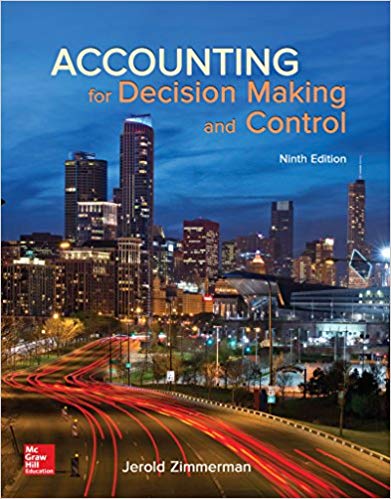SnapOn makes snap-together button fasteners (a male top and female bottom) for designer clothes. Each top and
Question:
SnapOn has achieved a good reputation among top design houses for producing high-quality, unique fasteners and a line of attaching machines that do not jam and do not mar the fastener. SnapOn has a staff of service technicians who maintain the attaching equipment 24/7. If a machine malfunctions, SnapOn guarantees that it will repair it within 24 hours, anywhere in North America. This service is very important to SnapOn's customers because fashion designers operate on short cycle times. Once they design their spring, summer, fall, or winter lines and show them to the buyers, the designers have eight weeks to produce and deliver the lines. Keeping their designs secret until they are released keeps other fashion houses and knock-off producers from copying their designs. The top fashion designers are willing to pay premium prices for high-quality fasteners that can be attached using highly reliable equipment.
SnapOn has two product lines (fasteners and attaching machines) and produces both lines in the same plant. Separate managers are responsible for the two product lines. Each manager receives 50 percent of his/her bonus based on reported net income of his/her product line, and 50 percent of his/ her bonus based on SnapOn's total net income. All manufacturing overhead of $59.615 million is applied to all products (attaching machines and fasteners) using direct labor dollars. All selling and service costs of $47.210 million are allocated to fasteners and attaching machines based on revenue dollars generated by each product line. The following table summarizes the operations of SnapOn (in millions) for the most recent fiscal year.
SNAPON FASTENERS
Summary of Operations
Last Fiscal Year
________________________ Machines ______________ Fasteners
Revenue ......................... $95.750 ......................... $132.895
Direct labor ...................... 22.650 ............................. 43.680
Direct materials ................. 24.640 ............................. 21.840
Required:
a. Prepare income statements for SnapOn's two lines of business (fasteners and attaching machines) that include manufacturing overhead and selling and service expenses allocated to each business line using the methodology described previously. Assume there are no beginning or ending inventories of either attaching machines or fasteners.
b. Senior management is concerned that its current costing methodology of allocating manufacturing overhead based on direct labor dollars is too simplistic and is not producing unit manufacturing costs that accurately reflect the true consumption of indirect manufacturing overheads. Since manufacturing overhead is about 50 percent of total manufacturing cost (direct labor, direct materials, and manufacturing overhead), small errors in cost allocations could materially affect the calculated unit manufacturing costs. Some foreign competitors are entering SnapOn's traditional fashion markets and are offering fasteners at prices below SnapOn's unit manufacturing costs. Garment manufacturers who use these foreign fasteners have to lease attaching machines from other U.S. manufacturers because the foreign fastener-makers do not provide their own attaching machines. SnapOn will not allow non-SnapOn fasteners to be used in SnapOn attaching equipment.
Senior management organizes a task force to study SnapOn's manufacturing overhead and selling and service costs and asks the task force to devise a better methodology for tracing these costs to individual products and the two lines of business. After three months of analysis, the task force presents the following breakdown of last year's manufacturing overhead amount:
.png)
The task force determines that costs in the purchasing department are driven by the dollars spent on direct materials. The depreciation of machinery should be charged to the two product lines based on the machinery used by the two product lines. Since attaching machine production and fastener production use different equipment, the depreciation of the manufacturing equipment can be directly traced to the two product lines. Of the $17.611 million of total depreciation, 70 percent is for equipment used to manufacture the attaching machines and 30 percent is for equipment used to manufacture fasteners. Employees are supervised either manufacturing attaching machines or manufacturing fasteners. So direct labor dollars are the cost driver of supervision expenses. The production of attaching machines occupies 75 percent of the total manufacturing space (square footage) and fastener production occupies the remaining 25 percent. Hence, occupancy costs (depreciation of the building, property taxes, property insurance, and utilities) should be assigned to products using square footage as the cost driver. Finally, engineers are assigned exclusively to either attaching machine production (60 percent of the engineering costs) or fastener production (40 percent).
The task force also examined the selling and service costs and determined that $11.850 million of the total $47.210 million consisted of service costs for the attaching machines (salaries, travel, and parts to maintain the attaching machines in the field). The task force also determined that selling costs of $35.36 million vary with revenues.
Using the task force's findings, prepare revised income statements for SnapOn's two lines of business (attaching machines and fasteners) for the last fiscal year. Assume there are no beginning or ending inventories of either attaching machines or fasteners.
c. Briefly describe any changes in the relative profitability of the two lines of business after implementing the task force's analysis.
d. Should SnapOn stay with its current costing system as portrayed in part (a), or should SnapOn convert to the new costing methodology based on the task force's analysis as portrayed in part (b)? Be sure to justify your recommendation based on the advantages and disadvantages of each alternative.
Step by Step Answer:

Accounting for Decision Making and Control
ISBN: 978-1259564550
9th edition
Authors: Jerold Zimmerman





